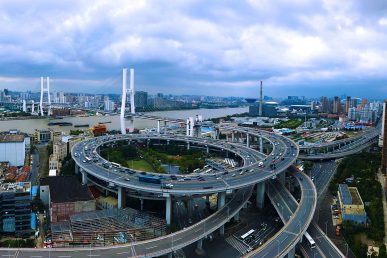Making city infrastructure more resilient
The systems that help us heat and cool our homes, provide drinking water, take away our garbage, let us communicate instantly with one another and enable travel — collectively known as infrastructure — will need to be designed differently in the future to become more sustainable and resilient.
In a paper published in MRS Energy & Sustainability, University of Illinois at Chicago civil engineer Sybil Derrible lays out two key sustainability principles that can be applied to infrastructure systems that would make cities both more sustainable and more resilient: reducing the demand for resources — whether it’s water, electricity or additional transportation infrastructure like roads — and increasing the supply of those resources, within reason.
“Cities are designed based on their location and needs,” said Derrible, associate professor of civil and materials engineering in the UIC College of Engineering. “Chicago was raised by close to 2 meters [6.5 feet] to create a sewer system to solve its flooding and sanitary problems. In other cities, buildings are designed to withstand earthquakes. Each city has its specific need and infrastructure design needs to take that into account.”
“Because of climate change, cities will need to become more resilient — power grids will need to supply more energy for cooling without becoming overwhelmed and shutting down, sewer systems will need to handle massive rain events… all these things need to be considered carefully going forward when it comes to urban planning,” he said. “These challenges are significant, but they also offer an opportunity to rethink how cities are planned, built, and operated.”
Derrible, who is also a research associate professor at the Institute for Environmental Science and Policy at UIC, notes that any new infrastructure project should consider first whether the demand for new infrastructure can be reduced so that new or more infrastructure doesn’t need to be built.
“But if we must build new infrastructure, it should integrate multiple functionalities,” he said. An example of integrated infrastructure would be installing green infrastructure in roads to prevent flooding on roads and sewer backups.
In his article, Derrible outlines guidelines for developing sustainable urban infrastructure that focus on the real-time supply and demand of services provided by seven systems: water; electricity; heating, cooling and natural gas; telecommunications; transport; solid waste management; and buildings.
In exploring each of the infrastructure systems from a sustainability point-of-view, Derrible found that reducing demand for heating/cooling and natural gas, transportation, solid waste management and buildings could best improve urban sustainability, while increasing infrastructure related to electricity and telecommunications could be achieved sustainably and within reason. Water, he concluded, could benefit from both approaches.
“We can apply both approaches to all systems — reducing demand and increasing supply within reason,” Derrible said. “But some systems were more amenable to one approach over the other to improve sustainability.”
Systems that can be increased should be integrated within current infrastructure systems, and whenever possible, new infrastructure should be multi-functional, he explained.
To make cities more sustainable, Derrible recommends the following steps for each of the seven infrastructure systems he examined:
Water
- Current systems can be improved to prevent loss (leakage)
- Make city surfaces more permeable to reduce impact of flooding due to rain events
Electricity
- Better building design and insulation
- More efficient air-conditioning systems
- Use more renewable energy
- Develop better energy storage technologies (batteries)
Heating/cooling and natural gas
- Improve insulation of buildings
- Use heat pumps instead of furnaces or radiators
Telecommunications
- Use more energy-efficient equipment
- Use sustainable energy sources to power telecommunication infrastructure
Transportation
- Increase shared mobility services (bike- and car-sharing services)
- Implement more travel demand management strategies like High-Occupancy Vehicle (HOV) lanes
- Provide more and better transit services
Solid waste (garbage)
- Reduce waste generated
- Reuse and recycle as much as possible
Buildings
- Promote smaller home sizes if possible
- Use environmentally-friendly building materials
This research was supported by National Science Foundation CAREER award 155173 and by NSF Cyber-Physical Systems award 1646395.


